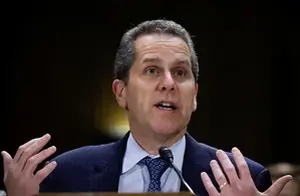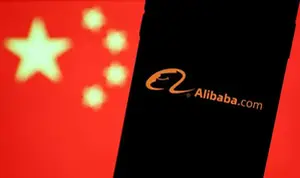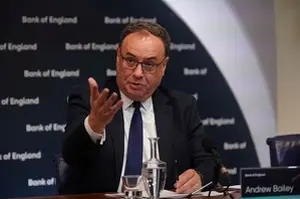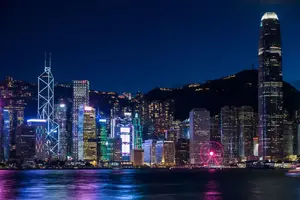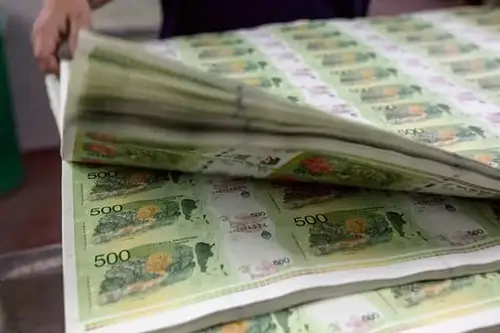
I just traveled to Argentina — and doubled my money with a 'black market' exchange rate
Waiting in an hourlong line at a Western Union wasn't on my initial itinerary when planning a recent trip to Argentina.
Yet there I was, in the bowels of a shop on Calle Florida in downtown Buenos Aires, sweating in the 95-degree heat along with local Argentines and other tourists, patiently waiting to pick up cash I had forwarded to myself from the U.S.
This might sound odd — maybe even dumb. Why waste valuable vacation time when there are often speedier ways to get money: withdrawing cash from an ATM, exchanging money at a bank or airport counter, or even just putting charges on a credit card?
More from Personal Finance:
These 10 metro areas are the most 'rent burdened' in the U.S.
How transportation costs are impacting high inflation
Why moving in retirement can earn you an extra $100,000
But the exchange rate here was too good to ignore — almost twice as good. This legal strategy is one that's based on a black market rate. Here's how it works.
A legal exchange rate influenced by the black market
In Argentina, waiting for a cash transfer isn't strange at all. In fact, it's custom — and an oft-recommended way to stretch your dollar there.
There are two main drivers: While the broader world has become increasingly cashless, cash is king in Argentina. Hyperinflation has also distorted the nation's currency market and led to the creation of multiple exchange rates.
When I visited in February, the "official" exchange rate — the one quoted by online currency calculators — gave U.S. tourists about 190 Argentine pesos per dollar. But the unofficial, "blue dollar" rate was nearly double that.
Put another way: Your money goes almost twice as far with the "blue dollar" exchange rate. This rate is set by underground exchange houses operating on the black market. Western Union is a legal workaround to get a similar rate.
You won't get the better conversion when transacting at an airport counter and, depending on the situation, may not when withdrawing from an ATM or using a credit card.
I learned this the hard way, only discovering how to get the better rate after exchanging $150 at the airport — and getting about half the pesos I otherwise could have.
Hence my trip to Western Union a day later, where, after watching a short video on how it works, I exchanged $350 for about 128,000 Argentine pesos on Feb. 13 — a rate of 366 pesos per dollar.
These dual rates aren't a new phenomenon in Argentina, or Latin America more broadly, economists later told me. But for me — a first-timer to South America who was unaware of this system— navigating them was curious and extraordinary.
"If you go back 40 years, you'd find multiple exchange rates in Argentina," said Monica de Bolle, senior fellow at the Peterson Institute for International Economics and a professor of Latin American studies at Johns Hopkins University. "It's just something that keeps coming back."
Why Argentina has more than one exchange rate
To have multiple exchange rates is to, essentially, not be able to agree on a currency's value — a perhaps strange concept for Americans, whose dollar is the world's de facto reserve currency due to its stability.
But in contrast, Argentina has a long history of high inflation and hyperinflation that, experts said, largely stems from economic mismanagement.
In 2022, the nation's inflation rate hit 95%, a three-decade high and among the most rapid in the world. For perspective, pandemic-era inflation in the U.S. peaked at about 9% — or a pace 10 times slower.
Argentina is now back in hyperinflation territory, de Bolle said. At the current pace, Argentines' money loses about half its value in a year, which decimates savings held in pesos.
As a result, Argentines seek out a stable currency for their savings so it doesn't lose value virtually overnight. And the U.S. dollar is that preferred store of value.
If you go back 40 years, you'd find multiple exchange rates in Argentina. It's just something that keeps coming back.Monica de Bollesenior fellow at the Peterson Institute for International Economics
The government, however, imposes foreign currency controls on residents, who are restricted from acquiring more than $200 a month (in U.S. dollars) via a bank.
Anyone who wants to save more cash in U.S. dollars must turn to the black market, which sets the "blue dollar" exchange rate.
The "blue dollar" rate is the one received when buying and selling a physical dollar at a "cueva" — Spanish for "cave" — which is basically a clandestine exchange house. Some are readily advertised by people on the street yelling "cambio," which means "exchange" in Spanish.
"It's going to be some random office in a building and every Argentinian who has any money at all does this a few times a week," Devon Zuegel, a writer and software engineer who lives part of the year in Argentina, said on a recent economics podcast.
Ultimately, the exchange rates are a story of supply and demand among Argentines, said Jonathan Petersen, a senior markets economist and foreign exchange specialist at Capital Economics.
The black market rate reflects the value residents place on stability. The peso premium they're paying for U.S. dollars relative to the official exchange is the rough equivalent of a year's worth of recent inflation, Petersen said — almost a no-brainer for any local intent on saving for the longer term.
"Every day, every week, every month, the peso will buy you less and less," Petersen said. "I think the fact that there's more than one exchange rate is the symptom of this monetary mayhem."
While these cuevas (the private exchange houses) are technically illegal, the government largely seems to turn a blind eye. A big chunk of Argentina's national debt is denominated in U.S. dollars, meaning that, in simple terms, the government needs a constant flow of dollars to be able to pay its debt, de Bolle said.
What's more, a more favorable exchange rate attracts American tourists, who bring their U.S. dollars into the country, with the added benefit of spending locally and supporting the economy, she said.
Argentina is a 'cash-demanding' environment
Meanwhile, Argentines are distrustful of banks and financial institutions, economists said.
They fear another "corralito," or a "little corral," a period in the nation's history when the government seized deposits during economic crises.
In 1982 and 1989, for example, it froze bank deposits and confiscated savings to finance operations and pay debt. In 2001, the government restricted access to deposits. The freeze lasted a year; when customers regained access to funds, they discovered their dollar deposits has been converted to pesos, which had depreciated significantly in value.
So, many Argentines like dealing in cash and stashing it away from banks, experts said. Sometimes, that influences behavior that might seem strange to a foreigner. For example, some lower-earning Argentines use part of their paychecks to buy a pallet of bricks; they can build a house brick by brick, which they view as a better store of wealth than holding on to pesos, Zuegel said.
For tourists, this distrust of financial institutions is important to know because many merchants may not accept credit cards as a result — meaning visitors should expect to need some cash for their purchases.
"Travelers from the U.S., Canada and Europe are incredibly accustomed to flipping out their debt card and tapping the credit card charge machine," said Jed Rothenberg, director of LandingPadBA, a travel agency focused on Buenos Aires. "You come to Argentina and it's the complete opposite."
"You're in a very cash-friendly environment," Rothenberg said. "Cash-demanding, in fact."
How to get a good exchange rate in Argentina
There are a few different schools of thought when it comes to exchanging money in Argentina.
Western Union is among the most common and best ways for tourists to access a favorable exchange rate for cash, travel experts said.
Here's how the process works, in simple terms: Americans forward cash to themselves online — via a bank account, debit or credit card — and opt for pickup at a Western Union branch in Argentina. The cash is then acquired in Argentine pesos.
The exchange rate offered by Western Union has been similar to that of the "blue dollar" rate on the black market. Acquiring cash this way is legal.
A Western Union spokesperson was unavailable to comment by press time on how the company is able to offer an equivalent exchange rate.
Visitors should be aware of potential snags: Lines and wait times can be long — even a few hours, locals told me — depending on the branch and time of day. It also may take a few days to access funds once sent, depending on delivery method. And certain branches may impose a dollar limit per transaction and there will likely be transaction fees. You'll also need to show your passport for pickup.
Every day, every week, every month, the peso will buy you less and less. I think the fact that there's more than one exchange rate is the symptom of this monetary mayhem.Jonathan Petersensenior markets economist at Capital Economics
Some tourists also go to cuevas. While not legal, they largely operate in plain view and typically offer the best exchange rates — and, as stated earlier, are like the country's worst-kept secret.
Tourists who opt for this route may be best served by asking their hotel, Airbnb host, tour operator or other trusted confidant for a recommendation on where to go, experts said. Tourists typically get the best exchange rates with crisp $100 bills; it may be harder to transact with worn-out or smaller bills.
I accompanied a friend to a cueva in El Calafate, a Patagonian town in the southwest that serves as a gateway to Glaciar Perito Moreno in Parque Nacional Los Glaciares. The cueva, recommended by our tour guide, was tucked away on the second floor of an upscale steakhouse, in a side room where a lone woman diligently traded bills from behind a fold-out desk.
However, "the black market has risk," cautions Sandra Borello, president of Borello Travel & Tours, a tour operator that specializes in travel to South America.
Aside from it being illegal, there's a chance tourists may get pesos that are fake or out of circulation, for example, she said. It may also make some tourists uneasy to carry hundreds of dollars in cash on them.
"I wouldn't recommend that at all," Borello, who is from Argentina, said of the cuevas.
The exchange rate at a cueva also isn't much better than at a Western Union, and likely wouldn't make much of a financial difference for someone visiting the country for a week or two, Borello said.
When she travels to Argentina, Borello pre-buys as much as possible — whether tours, hotels or otherwise — to avoid needing too much cash on the ground. For everything else, restaurants and other merchants are typically receptive to accepting U.S. dollars as payment in lieu of pesos, and generally give customers a good exchange rate, she said. Ask if you can pay with U.S. dollars, what the dollar-equivalent cost will be, and what (if any) change you'll get in pesos, she said. (Bear in mind: The merchant may not speak English. And, as with the cuevas, crisp bills are best.)
In addition, book an airport transfer ahead of time to avoid needing cash right away, she recommended.
Tourist credit cards have a new preferential rate
You may also not need as much cash as you may think, Borello added. The country is relatively inexpensive for U.S. tourists, she said.
Further, Argentina's central bank introduced a preferential exchange rate — the Dólar MEP — for tourists in November. Known as the "foreign tourist dollar," the MEP applies to credit card transactions. It's currently only available for Visa and Mastercard purchases.
As of March 9, Dólar MEP was trading at 376 Argentine pesos per dollar, on par with the black market rate. The "official" rate was 200 pesos per dollar.
Aside from trying to boost tourism, the government likely sanctioned the preferential rate partly as a way to help increase transparency into business' revenues — which is harder with all-cash transactions — and thereby increase tax collection, economists said.
"To have a foreign-issued credit card give you a rate closer to the blue, we've been waiting for this for years," Rothenberg said.
However, taxis don't accept credit cards, and many other merchants may not. You'll also need cash for restaurant tips. Credit card transactions also generally come with steep fees that can run users an additional 15% to 25%, though it's at merchants' discretion, Borello said.
As with all international travel, credit card users would be well served to consider a card without foreign transaction fees, too.
It's somewhat unclear as to whether tourists are getting the preferential Dólar MEP rate for ATM cash withdrawals. Locals offered conflicting reports. A Visa spokesperson confirmed ATM withdrawals would get the better exchange rate. A Mastercard spokesperson didn't respond to a request for comment.
The money situation is dynamic and rules could change quickly, travel experts said.
The cruel irony of the black market
There's a cruel irony to Argentines' use of the black market.
They turn to cuevas to convert their pesos to U.S. dollars out of financial necessity — but they may also be exacerbating hyperinflation, Petersen said.
All things equal, if many people are selling Argentine pesos to buy dollars, the dynamic puts downward pressure on the peso. Currency depreciation makes imports a bit more expensive, which then pushes up the inflation rate for those imported goods, causing Argentines to then worry more about inflation and nudging them to buy dollars with even more frequency.
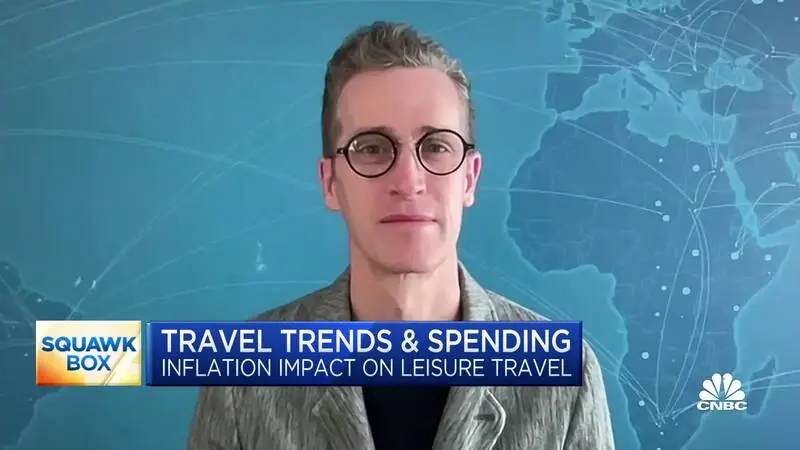
Of course, this is just one factor that might feed into runaway prices in Argentina. But it helps illustrate the bind residents are in.
"These things are ultimately costly, because they create a lot of distortions in the economy," de Bolle said of multiple exchange rates.
"It's a shame, because it's such a great country."
To that, I can wholeheartedly attest.
